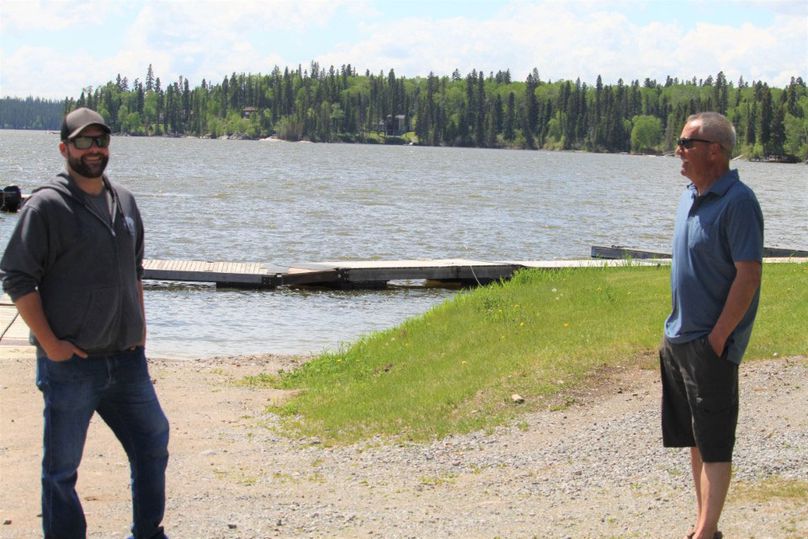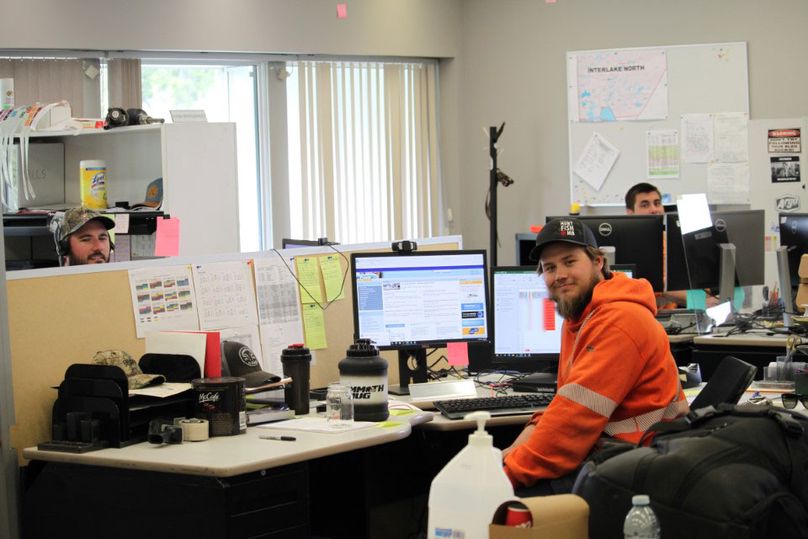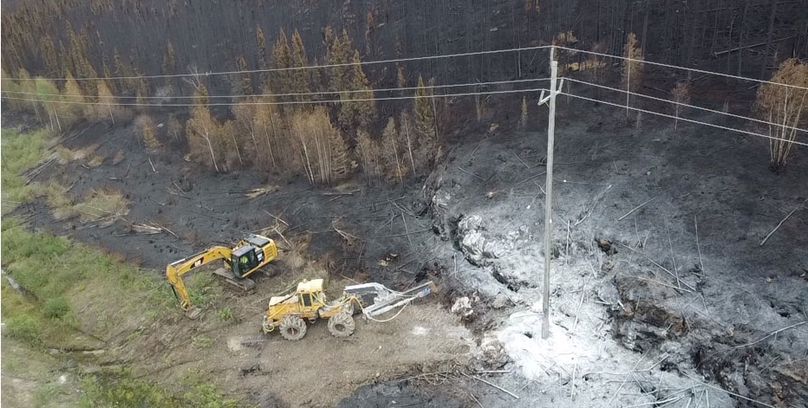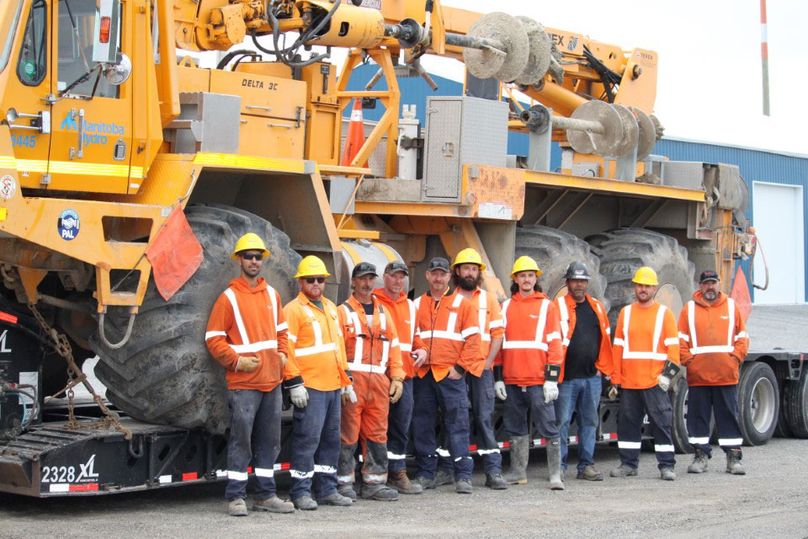As the whirring of helicopter blades gets louder and the chopper begins its descent, a few Hydro workers intent on their tasks in the Thompson Customer Service Centre (CSC) yard briefly look up. What might be a rare appearance of a coveted mode of transportation at a southern CSC is often just 3 p.m. in the north.
The giant Meccano toy descending from the sky is just one example illustrating the challenge and opportunity for people working and living north of the 53rd parallel, and the vital collaboration that brings Manitoba Hydro groups together across thousands of kilometres to keep Manitoba’s electrical system operating.
The repairs and maintenance crews undertake are often in remote locations and isolated communities and are only accessible by helicopters, float planes, boats, massive trucks, all-terrain vehicles known as flex tracks, or any combination of the above, says Marshall Shust, a Manitoba Hydro supervisor of Distribution Operations & Maintenance.
“You get comfortable real fast jumping on a plane or a helicopter,” said Shust. “Because of the remote locations we work in, we’re often flying in a helicopter — it can be almost daily.”

L to R: Marshall Shust and Ed Danyluk, recently retired manager of the Interlake North region, standing in front of Paint Lake, one of Manitoba’s best fishing spots.
Enlarge image: Two men stand beside each other with a lake in the background.
The Thompson CSC is the hub for Manitoba Hydro’s work in the region known as Interlake North, whose geographic area of responsibility ranges from the town of Arborg in the heart of the Interlake to Churchill on the banks of the Hudson Bay. The landscape is as diverse as the people who work and live there, with some areas deep in muskeg (a type of swamp or bog), or in a boreal forest, or in subarctic tundra.
“Because of our vast geographical area up here, we rely on each other a lot,” Shust said.
Three other CSCs – Arborg, Ashern, and The Pas – are included in Interlake North, a region covering more than 400,000 square km.
Despite the size of the area, Manitoba Hydro employees can stay connected to each other as they work to serve Manitobans. Technology introduced at the beginning of the pandemic helps with communication between workers in remote locations and the Thompson CSC located in Manitoba’s fifth largest city.

Estimator planners Mark Montgomery, Brett Lockhart, and Kraig Cober.
“We have our monthly safety meetings on Microsoft Teams with staff from Norway House, Cross Lake, Island Lake, Gillam, Lynn Lake, Gods Lake Narrows, and Churchill – but we might only see each other in person at our annual safety rodeo in the spring,” said Shust.
It’s an unusual work situation that attracts independent individuals who thrive under complex conditions and delight in solving problems others might find impossible to navigate.
For example, a wildfire that swept through South Indian Lake some time ago burned 24 wooden utility poles, triggering the mobilization of a construction crew in one of the most remote areas of Manitoba.
“We attempted to identify the damage with a helicopter the first day [after the fire], but it was too smoky,” said Shust. “One of our employees out of Lynn Lake was able to do a ground assessment and identified 24 poles that needed replacing.
“He called us and gave us a full report of the damage – and the location of the poles,” said Shust.

The wildfire that hit South Indian Lake meant Manitoba Hydro had to replace 24 wooden utility poles.
A key consideration when doing this kind of work is ease of accessibility to Hydro infrastructure.
“A lot of the area around South Indian Lake is boreal forest and muskeg,” said Brent Wyatt, an assistant district supervisor of rural operations. “It’s not the easiest terrain so we plan for the worst and hope for the best.”
At the time of the fire, a construction crew based out of Selkirk was nearby working to upgrade a different power line to keep up with customer demand and community growth.
That crew was able to redeploy, bringing along specialized equipment that would allow them to replace damaged poles and retrieve salvageable material.
They expected the job to take three days, but were done in two.
“It depends what kind of ground we’re on and whether it’s good for digging,” said Clayton Lussier, part of the construction crew. “If it’s good digging we can have things restored pretty quick.”

The Selkirk construction crew that helped restore power after a wildfire near South Indian Lake.
The South Indian Lake fire was just one challenge Manitoba Hydro’s northern crews contend with on a regular basis – but many Hydro employees living and working in the north wouldn’t trade it.
“I jumped on the chance to work for Manitoba Hydro,” said Erik Atkin, one of the crew who worked on restoring power after the South Indian Lake fire. Atkin says he loves the outdoors and finds it very fulfilling to help keep power on in Manitoba’s northern communities, and he joined the Crown corporation a little over a year ago.
Another Hydro employee who helped with that job, Landon Lamoureux, has a few more years under his belt. As a 25-year veteran, Lamoureux has been an operator driver the whole time, working to maneuver and operate large equipment through tough terrain.
All Hydro’s northern crews contend that working in the north isn’t for everybody – but for the independent, outdoor adventurer looking for a community of like-minded individuals who pull together to get the job done, who aren’t afraid to get their hands dirty, who revel in open spaces and off-hour opportunities for hunting, fishing, and exploring, the north is where it’s at.
And it’s not just construction crews and line workers – for Hydro’s office workers, living and working in the north is something special.
For Gloria Cook, a district support representative in Thompson, the reason she loves the north is a little counterintuitive – she loves the winter.
“There aren’t any bugs,” Cook says, laughing.
Originally from Split Lake, Cook has lived in Thompson for almost 20 years. She started working for Manitoba Hydro just over a year ago.
“I applied every year for 10 years for my job,” Cook said. “Hydro’s everywhere, and this is where I want to work.”

A group of administrative support workers at the Thompson CSC.
Enlarge image: A group of people sitting and standing inside an office and smiling at the camera.
There are distinct differences between working in the north and in the south, even when it comes to going to work at a desk.
“Inevitably, someone will ask one of my coworkers, Linda Flett, how she got to work that day,” said Kristal Baron, an office supervisor for Manitoba Hydro.
Flett works in Island Lake.
“In spring when temperatures are warming, Linda’s mode of transportation to get across the lake is in a sleigh behind a snow machine because they have to be careful about the ice breakup,” Baron said.
The experience of living and working in the north is a heady mix of challenging situations and problem-solving opportunities. Those who succeed and thrive in the north take calculated risks and know the importance of self-reliance and relying on others.
But when it comes to Manitoba Hydro’s core purpose – giving our customers Energy for Life – there’s no difference between north and south. Whether they’re up a pole, inside a generating or converter station, in an office, on the highways, or in a helicopter, boat, or on a plane, all of Hydro’s employees work as a unit to get the job done for our customers.



